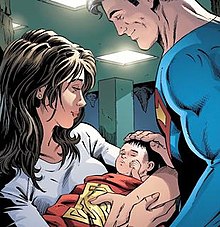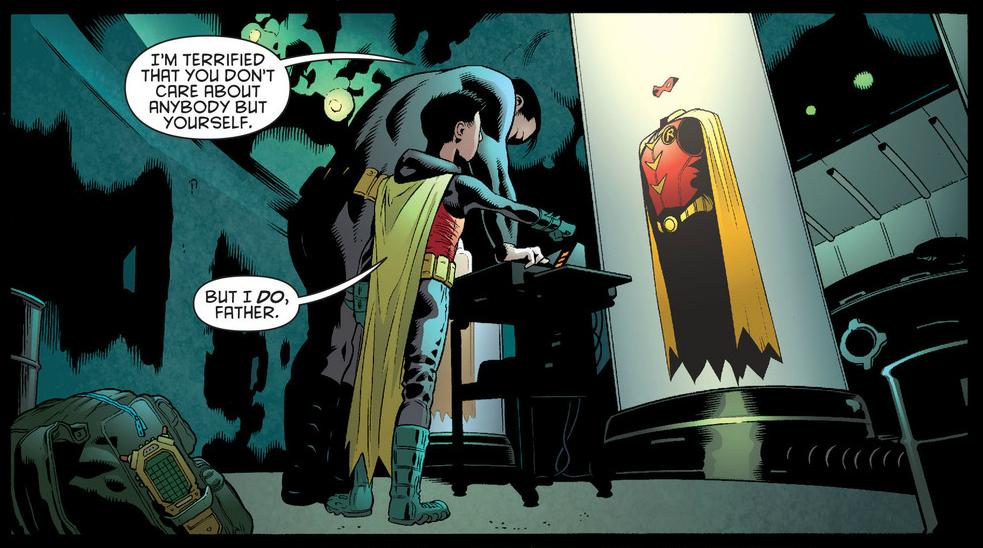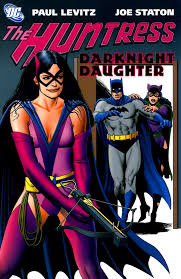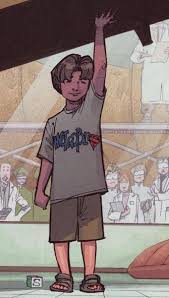Superman #7, by Brian Michael Bendis, Ivan Reis, Brandon Peterson and Joe Prado finally reveals what has happened to Jon Kent after heading off into deep space with crazy Grandpa, Jor-El. Upon returning, he has aged about 6 or 7 years. Yikes! This turn of events proposes a question, how are the children of super-heroes handled in comics?

For many years there were no children of super-heroes. Period. Characters didn’t age or grow as people do. They didn’t get married, they rarely died, and they certainly didn’t have children. They have usually been portrayed as perennially about 29-30. As comics began to grow up with their readership, characters began to age and go through real life experiences. In the mid to late ‘60’s, three signifiacant characters began to experience real life. Barry Allen married Iris West. Aquaman married Mera. And, Dick Grayson (the original Robin) moved out of Wayne Manor and went to college, returning Batman to the solitary character as he originally appeared in Detective Comics #27.

In Aquaman #23, October, 1965, Aquaman and Mera took a step even further. They had a son, Aquababy, or Arthur Curry, Jr. Unfortunately, Arthur, Jr. met a very untimely demise in Adventure Comics #452, July, 1977, murdered by Black Manta. Arthur, Jr. lived a short life, but provided plenty of angst, agony and story ideas for Aquaman over the ensuing 30 or so years. After a period of time, however, Arthur, Jr. was retconned from existence, or at least ignored. His death and absence does suggest a question, what if Arthur, Jr. had lived and been raised by Aquaman and Mera? It’s not dissimilar to the situation that Lois and Clark are in now in the Superman titles.

Jon Kent was introduced in Convergence: Superman #2 in the Summer of 2015. His story continued in the excellent Superman: Lois and Clark mini-series by Dan Jurgens and Lee Weeks. These issues brought the pre-Flashpoint Superman into “The New 52.” While creating some apparent paradoxes, the natural progression of Superman and Lois Lane’s marriage resonated with audiences as they were re-integrated into the DC Universe as the primary Super-couple during Rebirth, merging with “The New 52” versions and maintaining more pre-Flashpoint elements than “New 52” elements.

While Jon has enjoyed exposure during “Rebirth” and since in Super Sons and Adventures of the Super Sons alonside Damian Wayne, with The Man of Steel, Bendis’ foray into the Superman mythos, Jon has been shunted off world. It’s only with the January issue of Superman that we really get an inkling of what’s been going on with him. Despite the fact that Superman #7 is the best issue of his run between Action, Man of Steel and Superman in terms of writing, it essentially throws the character away. Just as Arthur, Jr. was killed, Jon’s uniqueness is also extinguished. He is now just another teenaged super-hero. Jon was the child son of Superman. Despite the fact that there are a nearly infinite number of ways in which this could’ve been explored, Bendis, in a most uncreative and disappointing fashion has thrown away Jon’s developmental years. It’s clear, Bendis has no idea how to write Superman as a husband and father, already shunting Lois off into a bizarre, inexplicable “I vant to be alone!” territory. It should be obvious form DC’s history that this not the direction that opens up storytelling opportunities. From the outset of his run, Bendis seems intent on hurting the Man of Steel instead of developing his character. This can only be due to a lack of skill or desire to make Superman seem real. His own internal argument is that Lois and Clark are not a normal couple, and yet despite the obvious support for this, in the end it shows he truly doesn’t understand the characters. Superman and Lois only work as a couple because they ARE normal. It’s what grounds Clark to his humanity, a result of his nurturing by Ma and Pa Kent. To say they aren’t normal ignores Clark’s childhood in a human home. Ironically, Bendis does understand this on some level in Clark’s reaction to Jon’s aging off world. However, this shows that while understanding the character, Bendis is simply not skilled enough to address normal development without introducing contrived plots designed to hurt Superman. There are numerous ways to explore Superman with a son, the least imaginative is to age him and eliminate the natural order of things. It is essentially an admission of a lack of creativity and ideas. The poor handling of Jon Kent does recall the sons and daughters of other characters that have been explored in a much more fulfilling and significant way.

First and foremost in this category is, Helena Wayne, the Huntress! First introduced in DC Super-Stars #17, the daughter of the married Earth-Two Batman and Catwoman became a fan-favorite, the Huntress went on to star in her own back up series in Wonder Woman, but was also a member of Infinity, Inc., a team of the sons, daughters and protégées of Earth-Two’s Justice Society of America. While Helena was introduced as an adult, her story is the result of the love and nurturing of Bruce Wayne and Selina Kyle. Instead of settling Batman with a child devoid of direction, Helena learns her father’s lesson and her mother’s love. Bruce and Selina raise their child together, nurturing a hero.

Notably, Infinity, Inc. provided more than just the Huntress. The series exhibited the many different ways that parents interact with their children. Fury was a true daughter of Wonder Woman, and her fiancé, Hector Hall, was a troubled, jealous son of Hawkman and Hawkgirl. Todd Rice and Jennie-Lynn Hayden showed that family can eventually come together, despite the obstacles. The point is that the normal affects more relatable and interesting dynamics. The greatest success of Infinity, Inc. is that it felt real.

The biggest drawback to Bendis’ run is that at no point do his plots feel natural or genuine. It is a supreme display of irony that Superman #7 is both his most technically well executed issue and at the same time horrific in content. This is what no one wanted to read. It not only eliminates potential stories that could’ve been something truly unique, but shows Bendis’s inability to address the normal development that defines humanity No mainstream super-hero has been depicted raising a child as part of main continuity.
Batman and Damian Wayne are the closest thing that been shown. Even with Damian, Bruce missed out on the first 10 years or so of Damian’s life. There was never potential for Bruce and Talia (Damian’s mother) to raise the boy with any semblance of normalcy. Animal Man is perhaps the one character whose children have been at the heart of the concept since his re-introduction to modern comics beginning with Grant Morrison’s run on the character back in 1988. As outstanding as this run was, Buddy Baker’s wife and children were ancillary characters. While present, they didn’t impact the direction of the book. In “The New 52,” Jeff Lemire centralized the family dynamic in his run, but also explored the victimization trope. Despite Maxine developing super-powers of her own, the fact that this was a title more inclined to horror, it did not lend itself to the normal approach of child rearing. Superman and Lois, though, for all the extraordinary aspects of their lives, were raising Jon as a normal kid, the same way Clark was raised by Ma and Pa Kent. Removing this from the premier couple in the DC Universe begs the question: Can a super-hero be shown raising a child? Aquababy didn’t make it, and the children and protogees of the Justice Society of America were only shown as adult children. Damian is the only super son or daughter that is getting any kind of guidance from a parent in-story.
There are a few other notable mentions that have been derailed along the way. Wall West and Linda Park, just pre-Flashpoint, were blessed with a son and daughter. The memory of his family has haunted Wally in the “Rebirth” era, and still has not been completely resolved. These issues attempted to show Wally and Linda raising super-powered children, yet they were casually thrown away once Flashpoint gave way to “The New 52.”
A few years before this, Lois and Clark, while not having a biological child, were saddled with a Kryptonian orpan who became known as Chris Kent. In the end, this boy turned out to be Lor-Zod, child of General Zod and Ursa. These issue of Action Comics written by Geoff Johns and Richard Donner attempted to explore what is being avoided by Bendis in his current run. However, Johns and Donner’s reveal of the true lineage of Chris Kent eliminated any further development of Lois and Clark as parents raising a super son.

Is it just impossible to show a super-couple raising a super-child? So far, it seems a high degree of conflict is necessary for storytelling, or the child is simply victimized. With super-hero marriages being more and more prevalent, retconned or not, it is only natural that children should come part and parcel with that life-changing event. Batman has an opportunity to do a bit of this with Damian, but Lois and Clark are in a more natural position to explore this aspect of life. There’s always a clamor for more diversity in comics, usually for race and sexual orientation. However, there’s a real opportunity to explore the family dynamic with a super son or daughter. As the average age of the comic reader increases, it’s only natural that the marketability of the family dynamic also increases. Hopefully, there’s an out for Jon and Lois and Clark won’t have a lifetime of regret ahead of them. Hopefully, DC will see the story opportunity instead of turning Jon into just another teenage super-hero.